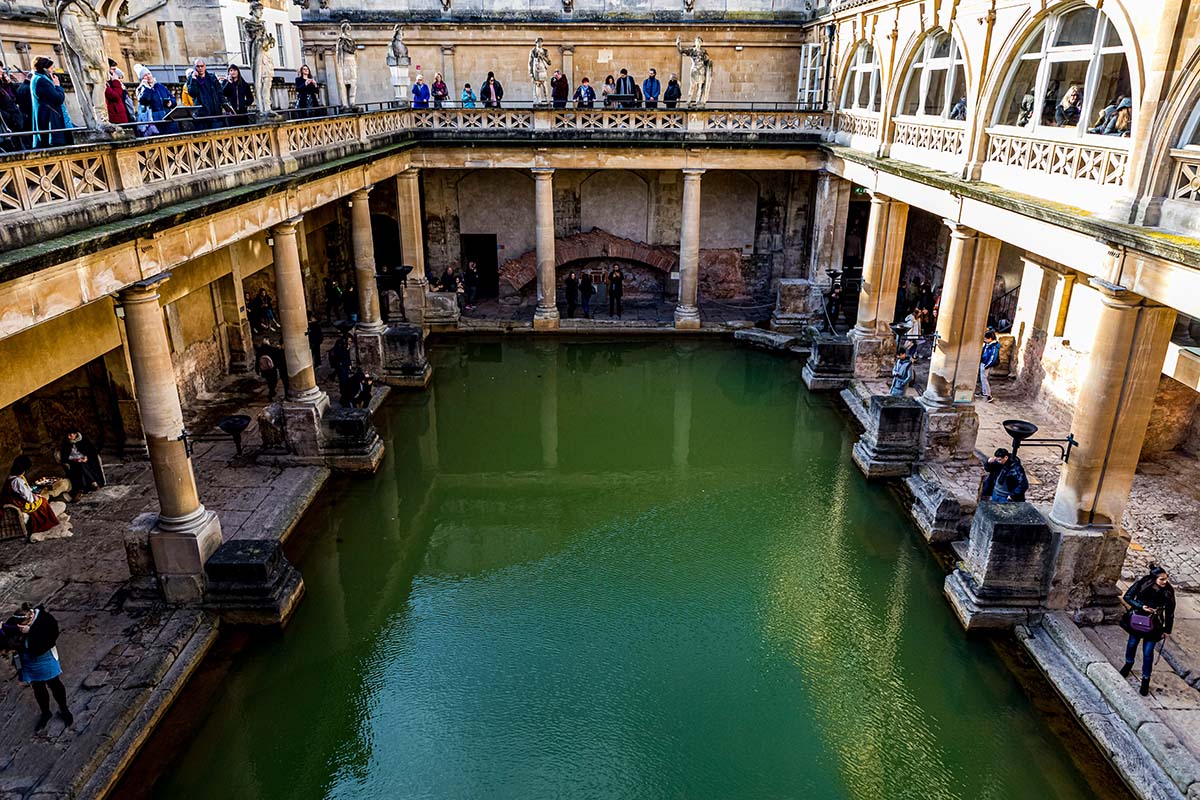From the old stone pool in the center of Bath, steam rose into the air like spectral whispers. For a brief moment, I could hear the echo of sandals on stone, the soft murmur of Latin conversation, and the sound of water being stirred by long-dead hands as I leaned over the rail and breathed in the potent scent of minerals. The experience was a silent dialogue with the past rather than merely a trip to a tourist attraction.
Traveling Through Time: My Experience at the Roman Baths
From the street, the Roman Baths’ entrance appears modest, but as soon as I entered, I felt as though I had traveled back in time by two thousand years. The remains of the Roman community of Aquae Sulis were revealed beneath the graceful Georgian façade, like a well-preserved time capsule.
I started in the Temple courtyard, which was formerly the spiritual center of the Roman Baths. You can still see the stone pediment depicting Minerva’s stern gaze and her helmet carved with striking detail, which was dedicated to Sulis Minerva, a combination of Roman and Celtic deities.
I continued to descend until I came to the Sacred Spring. Naturally heated by geothermal energy, the water bubbles up here at a steady 46°C. Thousands of coins, curse tablets, and offerings have been discovered in this pool, which the Romans regarded as a gift from the Gods. I pictured priests in long robes performing rituals as I strolled along the torch-lit path that circled the spring, steam and smoke curling upward.
At last, I arrived at the Great Bath, a vast outdoor pool that still contained the same mineral-rich water. The world above faded as I stood there. It was easy to imagine bathers in togas chatting, doing business, or easing their aching legs after a long day. Roman sophistication is evident in the engineering, architecture, and mosaics.
Of Gods and Boundaries: Cultures Colliding
The cultural fusion that Aquae Sulis embodied was what intrigued me the most. Not all indigenous customs were being trampled underfoot by Roman imperialism. Instead, local Celtic beliefs were assimilated by Roman settlers, resulting in a distinctive religious fabric. Minerva, the Roman goddess of strategy and wisdom, was combined with Sulis, the Celtic goddess of spring. The city adopted this hybrid deity as its spiritual patron.
I noticed representations of Sulis Minerva on altars and sculptures all over the museum. It got me thinking about how even conquerors have to bargain with the spirits of the territory they occupy.
As I walked outside the Baths, I couldn’t help but think about how many layers Bath wears. In addition to the Romans, the Georgians also left their mark with their colonnades and creamy stone crescents. From a holy spring, Bath became a popular resort in the eighteenth century. This location is ideal for those who enjoy historical juxtapositions. Every step is like traveling through time.
I strongly suggest using a printable poster of the Roman Baths layout or timeline for families organizing a trip or for those who learn best visually. When you’re on-site, it makes it easier to appreciate the chronology and adds an element of interactivity.
Bath’s Living History: From Abbey to Afternoon Tea
The architectural wonder of Bath Abbey, constructed in the late Middle Ages and subsequently restored during the Victorian era, is located adjacent to the Baths. I was astounded by how one city could support so many centuries as I stood beneath its fan-vaulted ceilings. This area has seen pilgrims, kings, and commoners light candles and offer prayers.
Just as it did for Georgian society, the Pump Room, located around the corner, provides a classy respite. I sipped tea while listening to live classical music, just like Jane Austen might have. A different era is brought to life by the décor, which includes chandeliers and immaculate white linen.
Bath is a modern city that celebrates its history rather than merely preserving it. Roman reenactments and contemporary spas that utilize the same therapeutic waters are among the available options. It’s also important to keep in mind that, depending on your nationality, Schengen visa appointments may be required in advance if you’re visiting from outside the UK, so be sure to adjust your plans accordingly.
If You Leave
How to Get There: By train, Bath is approximately 1.5 hours from London Paddington. It’s only fifteen minutes from Bristol.
What to Look for:
- Roman Baths: Make reservations in advance, particularly in the summer. The audio guide is excellent.
- Bath Abbey: Admission is free, but donations are accepted.
- The Pump Room: Ideal for afternoon tea or a historical lunch.
- The Royal Crescent and the Pulteney Bridge: Gorgeous strolls with picturesque vistas.
Expert Advice:
Optimal Time to Visit: For better photo lighting and reduced crowds, visit in the early morning or late afternoon.
What to Wear: Wear comfortable shoes because the old stones may be uneven.
Nearby: For a broad perspective of the city, hike a short distance to Alexandra Park.
Time is not linear in Bath. It reverberates off abbey walls, lingers in the steam rising from ancient springs, and circles around cobbled streets and mineral pools. Bath is more than just a destination; it’s a complex tale just waiting to be discovered, regardless of your interests in history, culture, or simply wanting to connect with the places you visit on a deeper level.
You might even hear the empire whispering back if you pay close attention.
About the author:
Anna Karapetyan is a Portfolio Manager, Educational and Youth Programs Specialist and SEO project manager.


